The year 1918 marked a tragic milestone in the history of American wildlife. On February 21st, the last known Carolina parakeet took its final breath in captivity at the Cincinnati Zoo. This event signified the extinction of the only native parrot species in the United States, leaving a void in the natural world that can never be filled.
The Carolina parakeet, also known as Conuropsis carolinensis, once flourished across the southeastern region of the United States. With its vibrant plumage of green, yellow, and orange, this beautiful bird was a sight to behold. Its range extended from states such as Florida, Georgia, and the Carolinas, all the way up to parts of New York and the Midwest.
Unfortunately, the decline of the Carolina parakeet can be attributed to a combination of factors, primarily human activity. Habitat destruction played a significant role in the bird’s demise. As settlers expanded their territories and cleared forests for agriculture and development, the parakeet lost its natural habitat. The destruction of large tracts of old-growth forests, which provided nesting sites and food sources, severely impacted the species.
Another major factor contributing to the Carolina parakeet’s extinction was rampant hunting. Farmers viewed the parakeets as pests, as they often fed on crops such as orchard fruits and grains. In an effort to protect their livelihoods, farmers would shoot the birds on sight. Additionally, the parakeets were sought after for their colorful feathers, which were used in the millinery trade to adorn women’s hats. The demand for these feathers led to widespread hunting and trapping of the birds.
The pet trade also played a significant role in the decline of the Carolina parakeet. The bird’s striking appearance made it a desirable pet, and many were captured and sold to collectors. The combination of habitat destruction, hunting, and the pet trade created a perfect storm that pushed the Carolina parakeet towards extinction.
Efforts to save the species came too late. By the time conservationists recognized the dire situation, it was already too late. The last known wild Carolina parakeet was spotted in Florida in the early 1900s, but it was unable to find a mate and eventually succumbed to loneliness and the harsh realities of a rapidly changing environment.
The Cincinnati Zoo played a crucial role in the Carolina parakeet’s story. The last captive parakeet, named “Lady Jane,” lived out her final days in the zoo’s aviary. Despite attempts to find a suitable mate for Lady Jane, the species had already reached the point of no return. On that fateful day in 1918, Lady Jane passed away, marking the end of an era.
The extinction of the Carolina parakeet serves as a poignant reminder of the impacts of human activity on wildlife and biodiversity. It serves as a cautionary tale, highlighting the importance of conservation efforts and the need to protect and preserve our natural world.
Today, there are ongoing efforts to learn from the tragic loss of the Carolina parakeet. Scientists and conservationists study the bird’s history, behavior, and ecological role in an attempt to prevent similar extinctions in the future. The story of the Carolina parakeet serves as a rallying cry for conservation and a call to action to protect and preserve the diverse array of species that share our planet.
References:
- Audubon – Remembering the Last Carolina Parakeet
- Smithsonian Magazine – Remembering the Last Carolina Parakeet
SEO Excerpt:
The last known Carolina parakeet, once widespread across the southeastern United States, died in captivity at the Cincinnati Zoo on February 21, 1918. This marked the extinction of the only native parrot species in the United States, primarily due to habitat destruction, hunting, and the pet trade. The loss of the Carolina parakeet serves as a poignant reminder of the impacts of human activity on wildlife and biodiversity. Learn more about the tragic story of the Carolina parakeet and its significance in the history of American wildlife.

